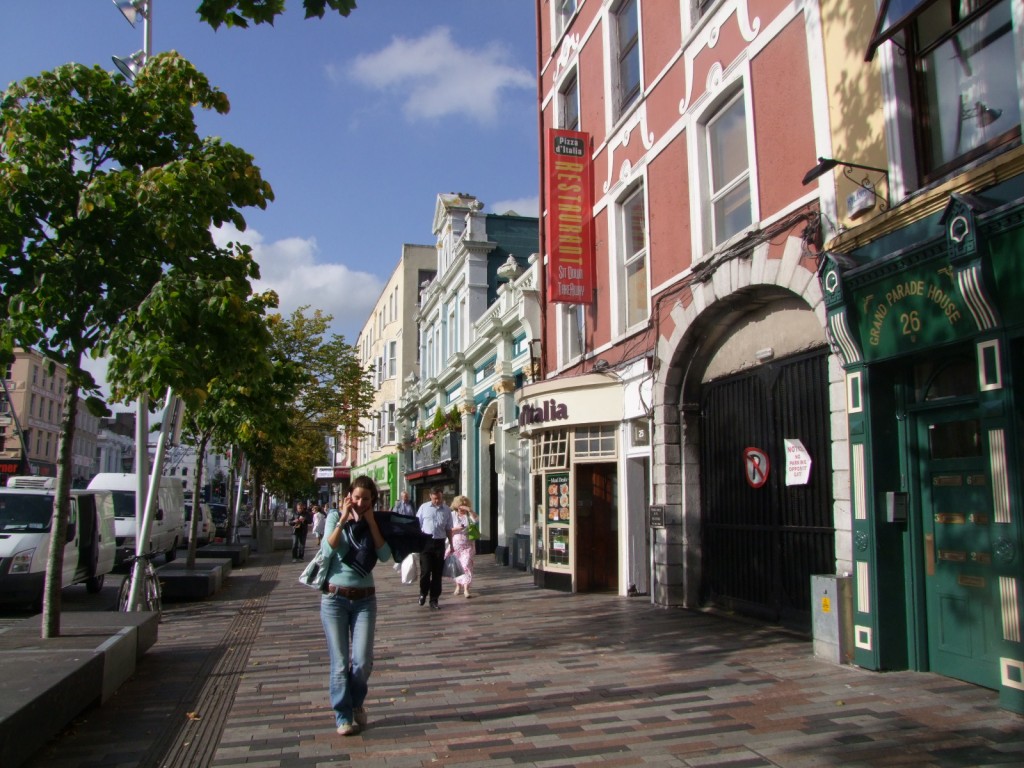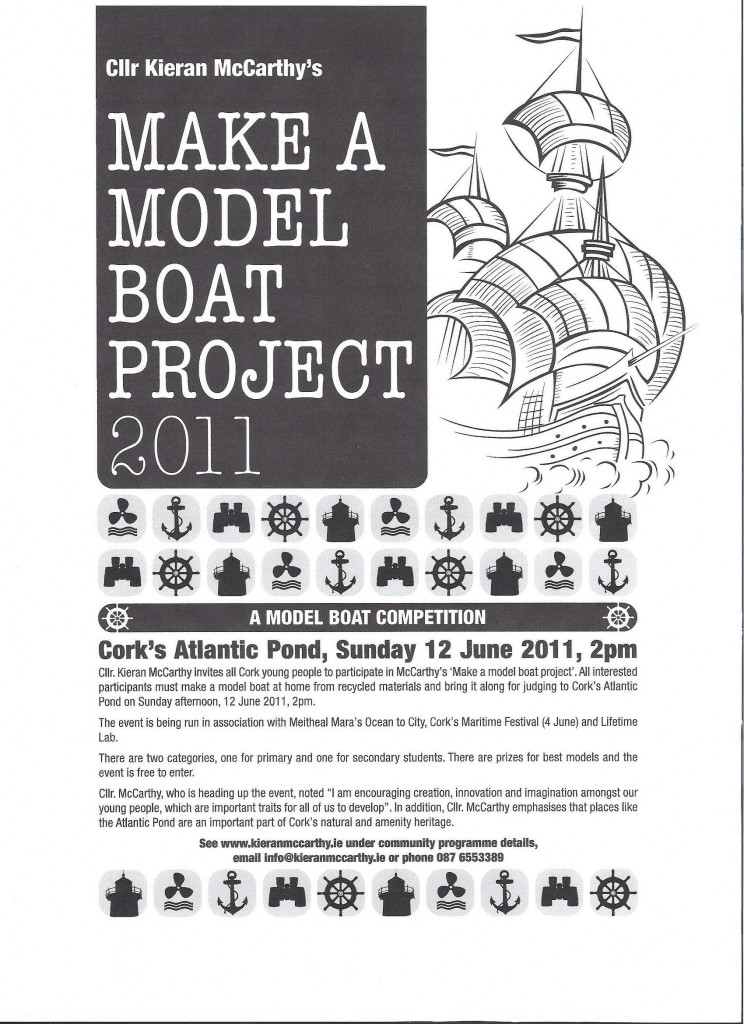
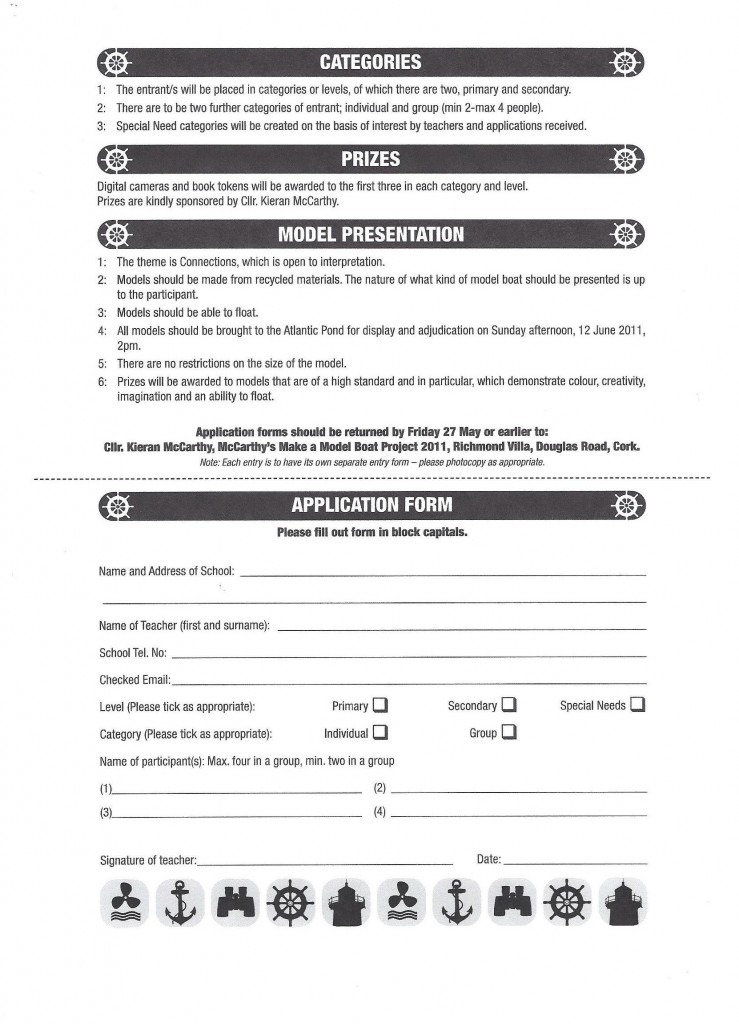


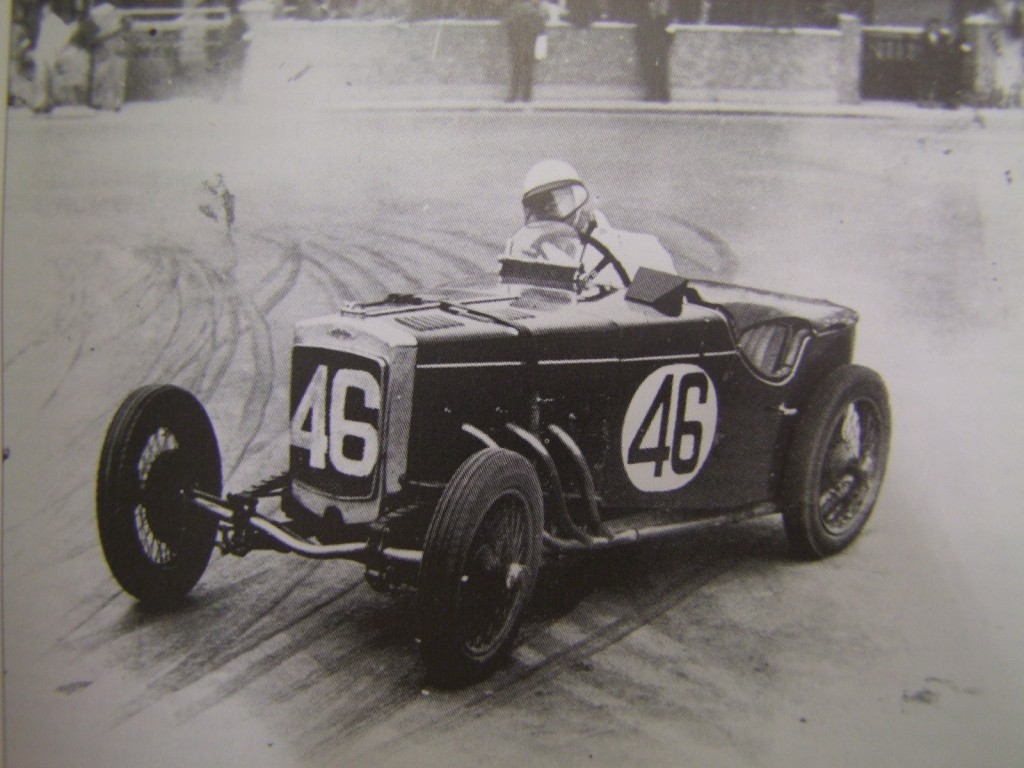
Article 590- 12 May 2011
In the Footsteps of St. Finbarre (Part 256)
Making a Cork Motor Derby, 1938
“Practice was at 6am…It was a really remarkable sight as thousands of men, women and children streamed on to the course in the light of the waning moon. Cigarettes glowed here and there, and motor-car headlights picked out the Carrigrohane Straight in bold relief against the blueness of the morning. Buses from all outlying suburbs of the city brought more thousands to swell the brave throng, which scorned such things as a very definite suspicion of frost in the air in its quest for speed and thrills” (Reporter, Cork Examiner, 21 April 1938, p.6).
The motor race of 1937 passed with great acclaim and it was not long before the Irish Motor Racing Club (under the organisation of Harold C. Brown) in association with the Cork and District Motor Club set out once more to further enhance Cork’s reputation as an Irish focal point of motor car racing. The Cork Examiner provides much detail as to how the next event came into being as does Wilfred Fitzsimmon’s book on Cork Motor Races, where he draws from the archives of the Royal Irish Automobile Club and the Irish Motor News for 1938
In January 1938, the announcement was made that the next meeting would comprise three races, a 200 mile race to be run under the new Grand Prix international formula, to be known as the Cork Grand Prix (with a prize of £1,000), a Formula Free race of 75 miles for cars not exceeding 1 ½ litres to be titled the Cork International Light Car Race (with a prize of £250) and a fifty mile handicap to be confined to racing and sportscars from Britain and Ireland and to be known as the Cork National Motor Handicap (with a prize of £100). Joseph McGrath, Managing Director of the Irish Hospitals Trust, was to present the entire prize fund together with a substantial contribution towards the organisation of the event. The starting money for the Grand Prix was higher that the going rate for Grand Prix meetings in Europe at that time.
From 1933 to 1938, the Grand Prix was run to the Formula Libre standard, meaning that there were no weight or engine restrictions. However in 1938, new requirements were enforced. A participating car without a supercharger had to have a minimum engine capacity of 1000cc and a maximum capacity of 4500cc for cars. The minimum engine capacity for cars with a supercharger was 666cc and a maximum capacity of 3000cc. There was a minimum weight of 400kg to 850 kg but this was on a sliding scale depending on the engine capacity. There was a free choice of fuel. The weight excluded fuel, engine oil and water.
The Cork 1937 organising team visited the racing departments of Auto Union, Mercedes Benz, Alfa Romeo, Maseratti, ERA, Délahaye and Bugatti. They were met with enthusiasm for the idea but the various departments flagged the problem of cars not being built and ready on time especially in light of the new Grand Prix formula.
Entries for the Cork Motor Races on 22 and 23 April 1938 amounted to a total of 47 cars. Twelve countries were represented amongst the entrants. For the principal race, the Cork Grand Prix, 15 entries were received including eight Italian Alfa-Romeos, two Italian Maseratis, while the entry list was completed by five French Delahayes. The Light Car Race attracted 19 entries with six British ERAs (English Racing Automobile) and nine Italian Maseratis. The handicap, which was confined to British and Irish drivers, attracted 13 entries, three from Great Britain, three from Northern Ireland and the remainder from Ireland. The ERA entry was down due to the new Grand Prix ERA not being ready. The same applied to the German Mercedes Benz and Auto Union.
The Ford Motor Company loaned a complete bay of their Cork plant for the use of the competitors to keep and work on their cars, in addition to giving equipment and facilities as required. The Irish radio authorities made special arrangements for the broadcasting of the running commentary on the event, which was relayed to many outside stations including England and perhaps further afield. There were also press facilities, which enabled representatives of home and outside newspapers to flash the result of the big race to the waiting public. Technical experts from almost every motor manufacturing company in Europe were present during the race period and before hand for the two days of practice.
The first morning’s practice for the Cork Motor Race brought 20 drivers to the course before dawn on Wednesday, 20 April 1938. It also brought 20,000 spectators, who took their places on the stand and at vantage points around the track by moonlight. Those of the spectators who came in search of thrills had many as the high powered cars sped down the Carrigrohane Straight at speeds of between 100mph and 140m.p.h. The main interest was focussed on the two French cars on the Straight Road, where one driver René Dreyfus gave some tremendous bursts of speed reaching 140m.p.h. as he passed the pits. There was also a large crowd present to watch the arrival of further drivers and their cars on the M.V. Innishfallen on Penrose Quay.
To be continued…
Captions:
590a.Dudley Colley, winner of the National Handicap Race, in his 1,4966cc Frazer-Nash, Cork, April 1938 (source: W. Fitzsimmons)
590b. Grand Stand and Pits nearing completion, Carrogrohane Straight Road, Cork, April 1938 (Source: W. Fitzsimmons)

Another year, well done to all the students involved in the Discover Cork: Schools’ Heritage Project 2011! Results below for the county schools. The award ceremony was last Thursday, 5 May, 2011 at 7pm in Silversprings Convention Centre, Cork! Thanks to the sponsors, Students, Schools, Kieran McCarthy, Mervyn Horgan of Lifetime Lab, Cork and Sean Kelly of Lucky Meadows Equestrian Centre, Watergrasshill
Fourth Class Individual:
1. Ronan Quirke, Emigration from Kinsale in the 1940s, Gaelscoil Charraig Uí Leighin, Co. Chorcaí (teacher: B. O’Muirgheasa)
2. Meadbh O’Riordan, My Family Connection with Kilmichael Ambush, Muinefliuch N.S., Macroom (teacher: E. Foley)
3. Lauren Healy, Carrigadrohid Dam, Muinefliuch N.S., Macroom (teacher: E. Foley)
4. Laura Phelan, St Finbarr & the Battle of Kilnaglory, Gaelscoil Charraig Uí Leighin, Co. Chorcaí (teacher: B. O’Muirgheasa)
5. Fionn Heffernan, The Port of Cork, Muinefliuch N.S., Macroom (teacher: E. Foley)
Fourth Class Group:
1. Cillian Fitzpatrick, Ray Shanahan, Evan Browne, Reenacreena Stone Circle, Reenacreena N.S. (teacher: M.Ronan)
2. Anna Hourihane, Ava Jones, Ellen O’Driscoll, Lorna O’Brien, The History of Reenascreena Village, Reenascreena N.S. (teacher: M. Ronan)
3. Aodhbha Pleimionn, Aoife Gallagher, Ballea Castle, Gaelscoil Charraig Uí Leighin, Co. Chorcai (teacher: B. O’Muirgheasa)
4. Cathal Creedon, Christopher Scanlon, Eddie Duggan, Seán O’Leary, Archaeological Sites in our Area, Muinefliuch N.S., Macroom (teacher: E. Foley)
5. Eamonn Shanahan, Jack O’Sullivan, David O’Regan, Peter Óg Hill, Farming in Reenascreena, Reenacreena N.S. (teacher: M.Ronan)
Fourth Class:
1. Cork City Bridges, Scoil Nioclais, Frankfield (teacher: M. O’Brien)
2. Gaeilscoil Charraig Uí Leighin, Co. Chorcai, 25 Bliain ag Fás, Gaelscoil Charraig Uí Leighin, Co. Chorcaí (teacher: B. O’Muirgheasa)
3. The Summit of Desertserges, Ahiohill N.S. (teacher: C. McCarthy)
4. The Famine in West Cork, Castlelack N.S., Bandon (teacher: V. Vaughan)
5th / 6th Primary Individual:
1. Matty Casey, Art Ó Laoghaire, Muinefliuch N.S., Macroom (teacher E. Foley)
2. Eabha Landers, A Scrapbook Through Time, Riverstown N.S. (teacher: D. Fitzgerald)
3. Michelle Lehane, The History of Fortgrady & Knockbrack Ambush, St. Brendan’s N.S., Rathcoole (teacher: M. O’Brien)
4. Lily Carey, My Family History, Castlelack N.S., Bandon (teacher: V. Vaughan)
Joint fifth:
Jake Adair, My Family History, Muinefliuch N.S., Macroom (teacher: E. Foley)
Gerard O’Hanlon, Kilcorney Creamery, St. Brendan’s N.S., Rathcoole (teacher: M. O’Brien)
5th / 6th Primary Group:
1. Michelle Crowley, Alexandra Lehrell, Killinardrish House and Gardens, Canovee N.S. (teacher: E. McCarthy)
2. Helen Dunne, Angie Moynihan, Shaunagh O’Sullivan, Shauna Lyons, Bawnatemple Graveyard, Canovee N.S. (teacher: E. McCarthy)
3. Jake Mulley, Aoibhne Creedon, Bawnmore Creamery, Muinefliuch N.S., Macroom (teacher: E. Foley)
4. Ava Long, Ellen Sheehan, Laura O’Dwyer, Mushera Mór & Mushera Beag, St. Brendan’s N.S., Rathcoole (teacher: M. O’Brien)
5. Ciaran Welband, Conor Frost, Peter Whelton, The Great Famine in West Cork, Ardfield N.S., Clonakilty (teacher: O. Whelton)
5th / 6th Primary Class:
1. Early West Cork Settlers, Ardfield N.S., Clonakilty (teacher: O.Whelton)
2. The Parish of Leap and Glandore, The Prides of Our Parish, Glandore N.S. (teacher: N. Whelton)
3. Classic Crosshaven, Scoil Bhríde, Crosshaven (teacher: S.O’Connor)
4. Derry Castle, Ahiohill N.S. (teacher: C. McCarthy)
Joint fifth:
5.Rosscarbery, Small Town, Proud People, A Heritage Tour, Glandore N.S. (teacher: N. Whelton)
5.Times Past in Whitegate, Whitegate N.S. (teacher: N. Mulcahy)
Junior Certificate Individual:
1. Naoise Ducker, The Legend of Priest’s Leap, St. Goban’s College, Bantry (teacher: J. Warren)
2. Cathal Hurley, West Cork Railway, St. Goban’s College, Bantry (teacher: J. Warren)
3. Niamh Buttimer, An Irish Man, Dr. Pat O’Callaghan, St. Goban’s College, Bantry (teacher: J. Warren)
4. Andy Forsythe, Kilmichael, St. Francis College, Rochestown (teacher: E. Henchion)
Junior Certificate Group:
1. Michael Healy, Madi McKenzie, Nathan Swanton, Aaron Barry, Bantry Fair Day, Then and Now, St. Goban’s College, Bantry (teacher: J. Warren)
2. Kate Mulcahy, Aoife Heffernan, Zoe Sohun, Our Project is on Conna Castle, Loretto Secondary School, Fermoy (teacher: M. Walsh)
3. Laura Ahern, Marie Clare Caplice, The Life, Work and Residence of Elizabeth Bowen, Loretto Secondary School, Fermoy (teacher: M. Walsh)
4. Clodagh Maye, Kate Enright, The History of Loretto Secondary School, Loretto Secondary School, Fermoy (teacher: M. Walsh)
Leaving Certificate Individual:
1. Radek Zuk, Roots in Gryfow, Branches in Mallow, Davis College, Mallow (teacher: C. Stanton)
2. Orla O’Connor, The History of the O’Keeffe Family, Davis College, Mallow (teacher: C. Stanton)
3. Ciaran McCarthy, Guide to the Boggeragh Mountains, Davis College, Mallow (teacher: C. Stanton)
Leaving Certificate Group:
1. Jamie O’Sullivan, Barry O’Neil, Ballyclough, Davis College, Mallow (teacher: C. Stanton)
2. 2. Cathal McGrath, Stuart Dineen, Peter Foyle, Finbarr Carroll, The Building and Areas of Mallow, Davis College, Mallow (teacher: C. Stanton)
Leaving Certificate Class:
1. Heritage Trails of Crosshaven, Transition Year Group (teacher: P. O’ Connell)
Community Heritage Awards
Margaret McElroy, My Grandmother, Muinefliuch N.S. (teacher: E. Foley)
Mathew Flynn, Dylan Trindles, A History of the Lower Harbour of Cork, Whitegate N.S. (teacher: F. Cavallo)
Best Model Entry (sponsored by Stephen Pearce Pottery)
1. Aideen Butler, Clonakilty Junction, Ardfield N.S., Clonakilty (teacher: O.Whelton)
Best Overall School Effort
Gaelscoil Charraig Uí Leighin

Kieran’s Our City, Our Town Article,
Cork Independent, 5 May 2011
In the Footsteps of St. Finbarre (Part 255)
Of Time and Motion, Cork 1937
“Though the entry is smaller than last year’s entry of 27…The score of the drivers entered are quite “cracks” in their own particular spheres…thus the Cork event will have the fastest cars of each class doing duty tomorrow fortnight” (Journalist remarks, Cork Examiner, 7 May 1937, p.10).
With preparations in place, only 20 of the 22 drivers made it to the 1937 Cork International Motor Car Race. The first practice was held on Thursday, 20 May 1937, in which 16 drivers took part in. Many thousands of spectators assembled at 6am to watch the practice, which was completed in sunshine. Very fast speeds were returned. The previous year’s winner Reggie Tongue set the pace with an average of 86.62 m.p.h. Unfortunately, one of the drivers entered for the race, Charles Meryvn White crashed and sustained serious head injuries. His car was one of the largest entered in the race, a 2,700 cc Bugatti, and was looked upon as a sturdy challenger for the main event.
The crash occurred only a few yards from the point at which in 1936 Charles turned a double somersault of his car. He then had a miraculous escape from death, sustaining only slight concussion, and was able to drive to the pits. This time round in 1937, approaching the steep down gradient to Inchigaggin Bridge on the back stretch, and about a half a mile before the Gravel Pit Quarry, his car crashed at 60 m.p.h. He skidded for sixty yards before hitting the left-hand ditch. The car jumped into the air and Charles was thrown out right across the road onto the footpath. The car plunged after him, but came to a stop at the kerbstone. Dr Ryan of Blarney and Dr Green of Collin Barracks, Marshals and St. John’s Ambulance dashed to his aid. His head was injured badly and within ten minutes he was conveyed to the Mercy Hospital. He died four days later in hospital on 24 May.
Despite Martin’s presence in hospital, the practice run was completed and all 16 drivers made the requirement to reach two-thirds of the actual speed needed to be in the race across three laps. At the second practice run on the Friday, the day before the race, Belfast representative C.G. Neill’s Bugatti went out of control at Mill Cross and struck the fence with great force. There were no serious results to the driver, but the car was badly damaged. With such accidents, precautions for the big race were heightened. At all the dangerous bends members of the Brigade were stationed with special appliances in case of accidents. Those included ceiling hooks at the end, by means of which, a competitor could be pulled out of a blazing car from a safe distance. In case of a driver being pinned under a car, long iron bars were provided, by means of which the car could be levered off the driver, therefore making way for the use of the ceiling hooks. The St. John’s Ambulance Brigade were stationed around the course, ten doctors, 28 nurses, 54 ambulance men and equipment, and five ambulances. The brigade was under the supervision of Dr. A.J. O’Sullivan and Supt. A.L. Downes. In addition, several hundred civic guards and close on 1,700 marshals were also on the course.
Saturday 22 May arrived with the big race starting at 3.30pm. The total distance was 201 miles and a lap of the Cork circuit, which encompassed the Carrigrohane Straight Road and the Model Farm Road in a circle, was 6 miles and 154 yards. The race was filmed and a summary piece can be seen on British Pathé (www.britishpathe.com/record.php?id=7822). There are various shots of the race start and stages in the race. In the actual race fourteen driver participated. An intense downpour of rain commenced after the race had been in progress for three-quarters of an hour. That made the day unpleasant for spectators and drivers alike. The drivers’ ordeal was nerve wracking, particularly on the back stretch, where the surface became dangerous. This had the effect of reducing speeds especially after the first six laps had promised a great struggle between two drivers. These six laps were fought for by Charles Martin and B. Bira but this was brought to an end, when Bira crashed on the back stretch beyond Inchigaggin Bridge and badly wrecked his car. Fortunately he escaped totally uninjured. A.P. McArthur of Sligo, also had a bad skid at Inchigaggin Hill, when his car struck a bank and swung blocking two oncoming cars which, however, just squeezed out of danger.
Of the fourteen starters five finished within the time limit. Charlie Martin set up a new lap record of 92.08 m.p.h. in the sixth lap, but then the rain commenced. The last half dozen laps also produced high speeds when the roads were dry again. The enormous crowd congregated principally on the two and a half mile Straight Road where high speeds were set up. The winner was H.B. Prestwich, of Cheshire, who averaged 76.33 m.p.h. in his 1,087cc MG Magnette, Anthony Powys-Lybbe, the previous year’s second, filled a similar role again, and Charlie Edward Capel Martin, was third.
To be continued…
Captions:
589a. Victoria Cross, Cork International Motor Car Race, 22 May 1937 (source: still from British Pathé, http://www.britishpathe.com/record.php?id=7822)
589b. H.B. Prestwich, winner of Cork International Motor Car Race, 22 May 1937 (source: still from British Pathé)

I had the priviledge of attending three concerts over the weekend for the Cork International Choral Festival, two of which I had the honour of deputising for the Lord Mayor. Well done to everyone involved.
Founded in 1954 to be a dynamic force in developing choral music in Ireland, the Cork International Choral Festival is held annually over the five days preceding the first Monday in May. Cork welcomes choirs from across the world for a programme of gala concerts, schools concerts, national and international competition, and world-class performances as thousands of participants bring the city to life for a celebration of choral music in all its many forms.
One of Europe’s premier international choral festivals, Cork is noted for its high standards, eclectic and wide-ranging programme, and the friendliness of its welcome. Festival events and performances centre around Cork’s City Hall, capacity 1,000; one of the most attractive and acoustically superb venues in Ireland.
Each year some of the finest amateur international choirs are selected to compete for the prestigious Fleischmann International Trophy. The selected choirs also participate in a wide range of festival events, which include fringe concerts, taking part in our church interchange programme across Cork city and county, and informal public performances which see choirs popping up throughout Cork in new and unexpected locations throughout the duration of the festival! The presence of these choirs from throughout the world gives audiences and Irish choirs alike the unique opportunity of hearing a diverse range of concerts and repertoire performed.
As well as foreign choirs, the festival annually features up to 100 Adult, Youth and School choirs who participate in National Competitions. Overall the festival attracts some 5,000 participants. The festival continues to ensure that choral music, representative of many historical and cultural traditions, is brought to the people of Cork and the many visitors who we are delighted to welcome to the city for the event.
http://www.corkchoral.ie/index.php/home.html













Last Wednesday (27th April, 2011), the final of my third year of my Community Talent Competition took place at the Vertigo Suite or the 17th floor of Cork County Hall. Thanks to everyone for their support. I would like to thanks the finalists for their determination! You were all great! well done!
Junior Section:
Alexandria O’Donnell
Aisha McCarthy
Kelly Ann O’Flynn
The Pixie Chicks Group
Helen Nagle
Emma Field & Sarah Cronin (second place)
Aisling Donnelly (first place)
Pretty Little Liars Group (fourth place)
Cillian O’Sulivan (third place)
Senior Section:
Taylor Webster (second place)
Laurie O’Donnell (joint third place)
Ciara Crowley (joint third place)
Shannon White (first place)
My thanks also to Rob our video man, our sound man, Nicki Ffrench Davies and Livy Riordan for their mentoring, our judges Clare and Tess for their time and patience and Yvonne Coughlan of Red Sandstone Varied Productions for producing the project as always with enthusiam and flare!.






















McCarthy’s Artist in Residence Programme
Cllr Kieran McCarthy, through his ward funds and community programme, is seeking an artist from the south east ward of Cork City to take up his artist in residence scheme. Cllr McCarthy has teamed up Sample-Studios on the 2nd floor of the former FAS/Revenue Government Buildings at Sullivan’s Quay, Cork City to provide a studio space for a three month residency. Cllr McCarthy is searching in particular for a painter/ sketch artist with some experience and looking to pursue further work in a studio. Cllr McCarthy is particularly interested in completing a programme encompassing historical impressions of the city (artistic interpretations of eras in Cork’s past using maps and historical sources plus also perhaps to pursue artwork with a historical vein in the rich landscapes of the south east part of the city). The nature of the work is open to interpretation and can be negotiated.
Sample-Studios Limited is a non-profit association established at the beginning of 2011 by an artist-led board of directors hailing from a range of disciplines including, textiles, media, sculpture, paint, music and drama. The purpose of this association is to support and promote emerging and established contemporary practitioners of the arts from Cork and beyond, through affordable artist-run studios, to sustain and develop local, regional and international initiatives and to promote research and community outreach projects. Many of the members of the group offer education and help in areas such as computer design skills, arts administration, accounting and management skills as well as offering exhibition opportunities for the members of Sample-Studios.
For further details of McCarthy’s Artist in Residence Programme, please contact Cllr Kieran McCarthy at 087653389.
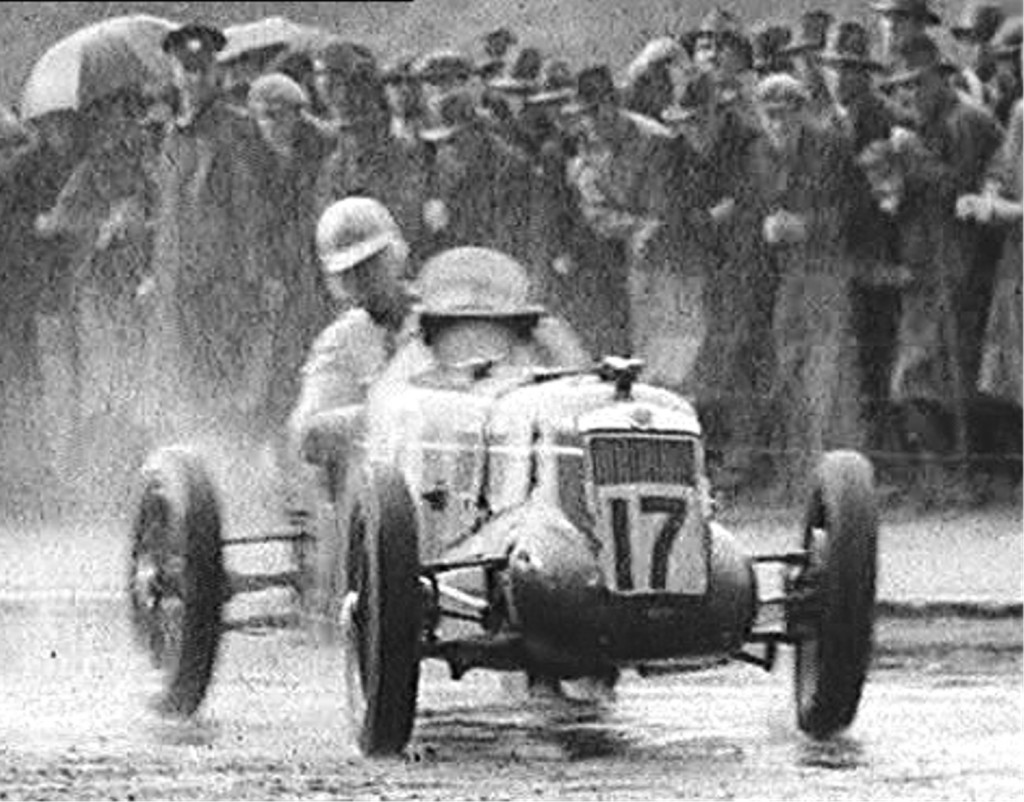
Kieran’s Our City, Our Town Article,
Cork Independent 28 April 2011
In the Footsteps of St. Finbarre (Part 254)
Planning an International Motor Car Race
The effects of the Cork Motor Race on the Carrigrohane Straight Road on Saturday 16 May 1936 were enormous. The bringing of a huge ‘floating’ population to the city and the spending of a large amount of money was very welcome. Hundreds of cross channel visitors availed of their visit to Cork to make tours of the surrounding countryside and many of the famous tourist spots such as Glengarrif, Killarney and Parnasilla.
The bank clearances on the Monday after the race were the largest experienced for many years, and according to businesses, the amounts, which changed hands in Cork between Thursday before the race and the Monday after the race surpassed even the busiest Christmas seasons for the previous decade. Hotels, cafes, restaurants, garages and shops all reaped dividends from the race and the effects of the event were beneficial to every section of the community. It was therefore no surprise that the organisers set out to organise another race the following year in 1937. Preparations began with the aim of obtaining international recognition for the proposed event. The Cork and District Motor Club (formerly Cork Motor Race Committee) joined the Irish Motor Race Committee (IMRC) in promoting the race.
The planned race was elevated to international status by the international body of motor sport at the request of the RIAC. In addition, Cork County Council widened the Carrigrohane Road by nine feet, which allowed for faster speeds to be recorded. The race was planned for 22 May 1937. The entrants themselves were well known names on the racing circuit, some of whom much have been written about in books and results catalogued online by motor car enthusiasts. The high calibre of the motor car drivers brought to Cork is a testament to the all those who organised the event and sought to make the Cork event an international one. The Cork Examiner on Friday 7 May, 1937 recorded a final list of 20 entries for the Cork Race. The Irish contingent comprised Frank O’ Boyle, Dublin, C.G. Neil. Belfast, A.P. MacArthur, Sligo, Charlie H.W. Manders, Dublin and A.J. Thompson, Mallow. Charlie Manders was 250 cc motor cycle champion in the late 1920s. He set up an Adler dealership in Dublin selling Adler motor cars imported from Germany. He was a very successful private entry racing driver. Charlie built the chassis of an Adler Trumph Junior, a single seat racing car, and he went on to race in Ireland in the 1930s up until the war.
The English contingent, like the previous year, comprised big names on the motor car race circuit. Motor car historian Leif Snellman has attempted to compile short biographies online of some of the names (http://www.kolumbus.fi/leif.snellman/main.htm). Reggie Tongue, the winner of the Cork race in 1936 made a return. He had an address from Eccles, Greater Manchester. Born in Urmston, Lancashire in 1912, Tongue was born into a family where his father was a motor car racing driver. Reggie’s father died while Reggie was still at school. After some effort Reggie finally persuaded the trustees to release money for him to order a new Riley car with which he began his career in reliability trials. While at Exeter College, Oxford in 1935, he purchased a MG Magnette and the next year he bought an ERA-B.
B.Bira (London address) was a member of the Royal Thai family, Birabongse. He came to England in 1927 to study at Eton and Cambridge. He started racing in 1935. Charlie Edward Capel Martin (Surrey address) was a Welch driver born in Abergavenny Monmouthshire in 1913. He started racing at Southport sands on the Lancashire coast in 1932 moving on to circuit racing driving an MG, also racing in Bugattis and Alfa Romeos at Donnington and throughout Europe at Pau and Deauville in Grand Prix. He gained wins at Brooklands, Surrey in 1936.
Percy Maclure, (Coventry address) was born in Skipton, Yorkshire 1911. He worked with his bother Edgar Maclure for Riley. Wiliam Riley was a British motorcar and bicycle manufacturer from 1890. The company became part of the Nuffield Organisation in 1938 and was later merged into British Leyland. Ivo Peters (Bristol address) was born in 1915 and was a English railway photographer. Peters spent his life in Bath, Somerset and is best known for his amateur photographs and cine films of steam railways in the British Isles, particularly of the Somerset and Dorset Railway. While studying at the University of Cambridge, his interest was diverted to road racing in Ireland.
Anthony Powys Lybbe (Berks, Berkshire address) was born in Streatley-on-Thames, Berkshire in 1909. At age of 18 he went to the Royal Military Academy, Woolwich, London for officer training within the Royal Corps of Signals. He left the army by 1933 and amongst other interests took up motor-racing.
The other UK drivers were Peter Whitehead (Harrowgate address), Sir Alistair W. MacRobert (Surrey address), Cyril Mervyn White (Buckinghamshire address), W.H. Dobson (Surrey), J.F. Gee (Cheshire), H.B. Prestwich (Altrincham address, Greater Manchester), John Henry Smith (London address) and A.P. Watson (Surrey). There was one woman driver Mrs. A. C. Dobson from Sussex who drove her husband’s 1 ½ litre Riley.
To be continued…
Captions:
588a. Victoria Cross, Cork International Motor Car Race, 22 May 1937 (source: still from British Pathé, http://www.britishpathe.com/record.php?id=7822)
588b. Carrigrohane Straight Road, Cork International Motor Car Race, 22 May 1937 (source: still from British Pathé)
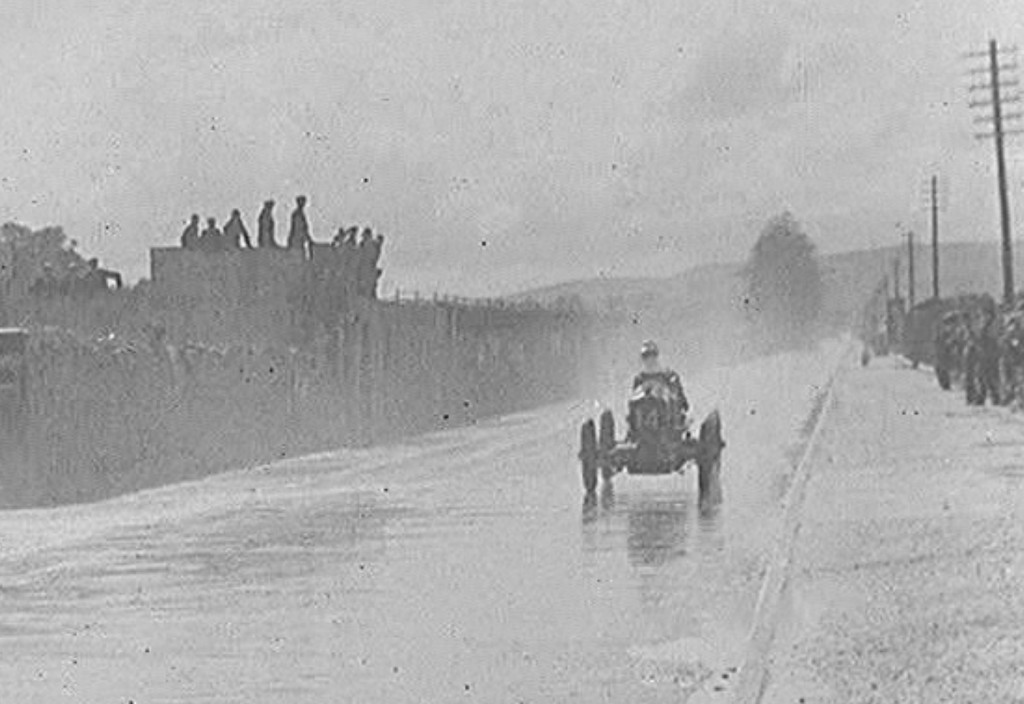
Check out Cork c.103fm at 6pm this evening (Wednesday 27 April). I’m on with Martina O’Donoghue on my life and times she told me plus some of my favourite tunes!
listen online here: http://www.c103.ie/
Lord Mayor, I’m a firm believer that in the public service and in terms of work ethic there are the good, the bad and the ugly.
And if you find the good, a public representative is lucky and it is those public servant employees that should be nurtured, encouraged and inspired.
I think in this economic climate, Irish society has been over harsh on the public servant. There are many who really enjoy their job making a difference and they should be encouraged to develop their talents and not hindered by cuts, cuts, cuts.
I also think in that light, there is way too much emphasis on rebuilding the economy and too little emphasis on rebuilding society after the crash. We are also turning into a society of worriers and of apathy. I happened to be in Germany recently and the headline of one of their national newspapers read that “Ireland has lost its self confidence”.
And so when I look at the danger that this city will lose five community wardens whose job brief encompasses building a sense of confidence in our communities, I am completely appalled and annoyed.
Their work ethic reveals the work of not just five people but probably that of 20 people
One reads in this report of bonfire nights events, clean-ups summer camps, walking groups, summer fun days, voluntary emergency services exhibitions, supporting local youth cafes, patrol of estates, calling to people and businesses, home visits, overseeing the probation and welfare graffiti,painting schemes, local schools work, Muga mornings, driving the community buses and so much more
….and we as a Council are happy to blasé accept that there is no funding there to secure their jobs
They are probably doing the work of 20 or more people, what we get for E.200,0000 their collective wages, we reap dividends in moving the areas they pursue work in …
I’d like to call upon this Council to write to the relevant minister, bring him to Cork and show him what work is going on and what he is getting in return for these community wardens.
If we don’t secure these jobs, this city will have to pay more to clean up the growing worry and apathy inherent in Irish society.
